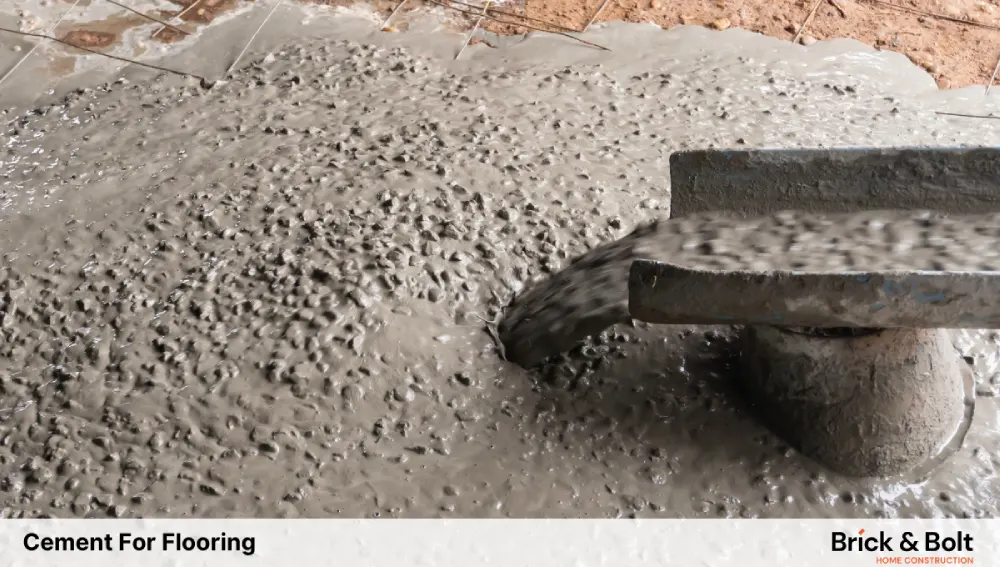The history of cement starts from over 6500 BC. Evidence displayed that the regions of Jordan or Syria used concrete floors and in buildings. However, the ancient Romans were the first ones to create proper cement and used it in almost all their construction.
Cement can also be used in flooring as it can resist wear, fire, water, odour, and bacteria. Moreover, they don’t cause scratches and are easy to clean. In India, the cost of concrete per square foot ranges between Rs. 40 and Rs. 400. Hence, cement play a crucial role in flooring, and this blog explains its use in detail.
Types of Cement Flooring
There are different types of cement flooring to look at before selecting the type of cement for your floors.
Polished Concrete
Polished concrete is a type where the naturally sturdy concrete adds a little touch of luxury to the house. To get polished concrete, the constructor uses the standard 5:1:5 ratio of cement, sand, and aggregate.
These components are then ground into fine paste with the right equipment, creating polished and glassy concrete floors. These floors can withstand spills and contamination and can resist any damage.
Stained Concrete
Stained concrete in its natural form remains plain without any designs. However, by adding acid-based stains, different types of designs and patterns can be created, making them suitable for commercial or residential places. Moreover, the designs and colours are customisable according to the owner.
The colour will not chip, change, or deteriorate as it penetrates deep into the concrete and remains in it. These concrete floors require low maintenance; however, waxing once in a while can retain the shine and add aesthetics to the interior of the building.
Terrazzo-Style Concrete
Terrazzo, a composite material made from chips of marble, quartz, granite, or glass set in concrete or epoxy, adds a stylish and durable touch to flooring. This style of concrete flooring is classy yet durable. The terrazzo finish permits the floor to achieve a distinct finish and design. Terrazzo is a little different from polished concrete.
In terrazzo, the concrete slab is covered with epoxy, and the aggregate is ground and then polished at the end. However, polished concrete is just a slab.
The terrazzo style of concrete flooring is at least 30% stronger than normal concrete flooring. They offer a wide variety of customizations and cover the benefits of concrete.
Epoxy Flooring
The epoxy type of concrete takes the game of flooring to the next level. They are designed not only to resist everyday activity but also to resist stains, moisture, microbes, and chemicals.
Epoxy does come in different forms, namely flaky, quartz, and metallic. Epoxy flooring is one of the versatile flooring options, as it creates shine, goes well with lighting, and is also slip-resistant.
The flooring can be used in the kitchen, bathroom, or other rooms that require water-resistant flooring.
Pros and Cons of Cement Flooring
Cement flooring has its own positive and negative sides, and a glimpse of them is described below:
Pros of Cement Flooring
Durability
Concrete floors are sturdy materials that are environmentally and commercially used by the majority of people in construction. The flooring material can support heavy furniture, scratches, and elevated temperatures. When compared to other flooring materials, they require less maintenance.
Range of Designs
Cement floors come in different designs and colours and can offer you a range of luxury touches to your house. Concrete can incorporate acid-based stains and paints that give them vibrant colours, while rubber stencils can add texture to them. They can be used to create beautiful combinations of durability and sophistication.
Incorporation of Heat in the Floors
The concrete, when poured over a slab, has options to introduce heat cables or water tubes that create warm floors during winter days or cool floors during summers.
Disadvantage of Cement Floors
Hardness
Cement floors are hard, and not everyone finds them comfortable. Moreover, cement floors are heavy and can be a good catch for buildings on the lower floors; however, when they have to be used on the second floor, then the overall building should be able to sustain it. Hence, it is important to decide based on the overall factors of your building.
Collect Moisture
Cement flooring may experience damage if there is water movement down to the foundation. They can collect the water, which over time may affect the paint and get damp.
Environmental Susceptibility
Cement flooring as a whole is a reusable and biodegradable material. However, the making of cement releases enough energy to generate a lot of carbon dioxide. So, they may be environmentally unsustainable.
Conclusion
In summary, cement flooring is a good option with numerous benefits. The cement materials used in flooring are durable, prevent microbial growth, resist scratching, and resist fire. However, cement flooring is still on the rise and gaining traction, mainly among people who have pets. There are certainly advantages and disadvantages to cement flooring, and one must opt for the type with careful consideration.
FAQs
Compared to tiles, concrete flooring can withstand wear and tear; apart from that, it is resistant to fire and requires less maintenance compared to tiles.
Polished concrete floors are indeed cheaper compared to hardwoods. This makes concrete floors a high-traffic option compared to other materials.
Not all buildings can support concrete floor elevations; however, when the building is still in the planning phase, the architect can decide on the option of incorporating it and make the required additions.

